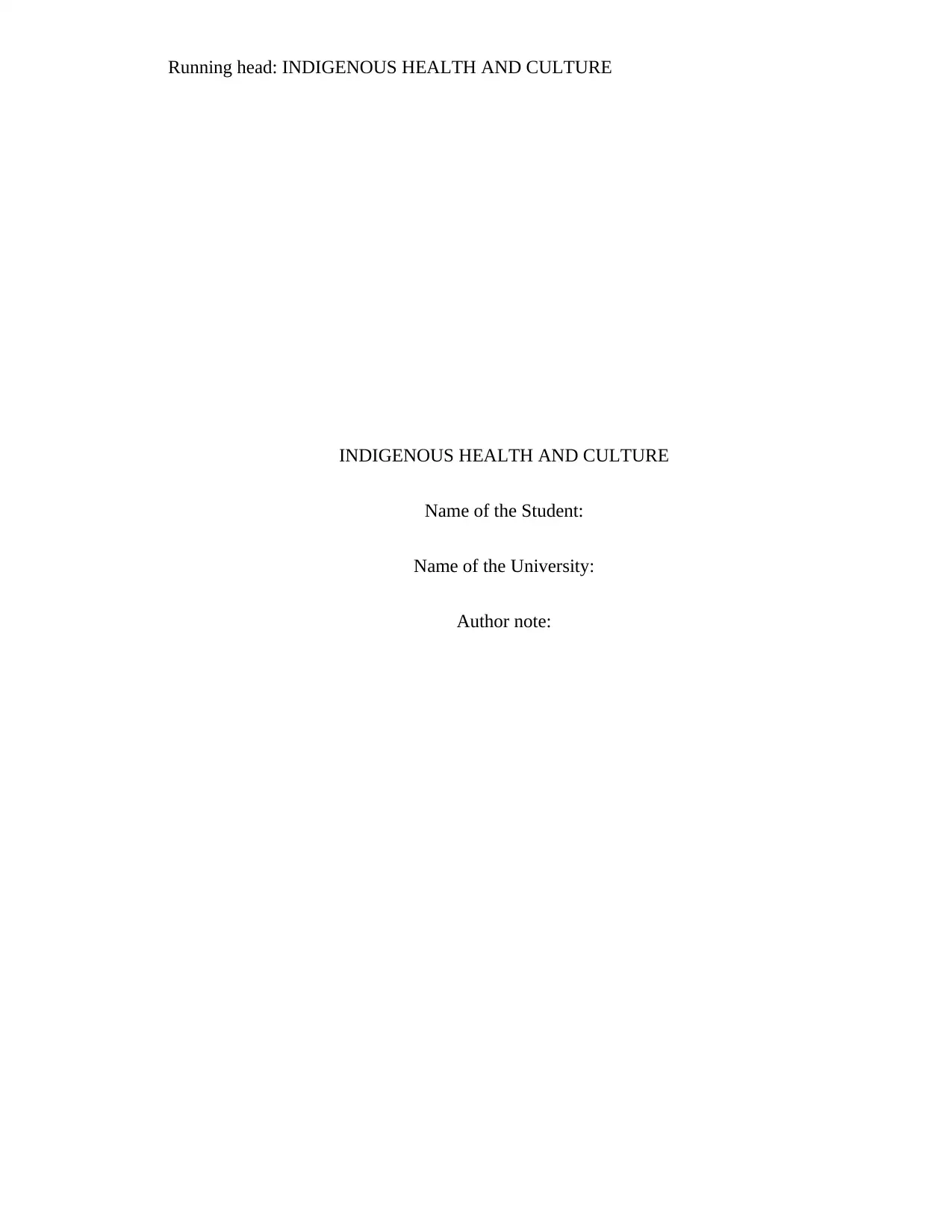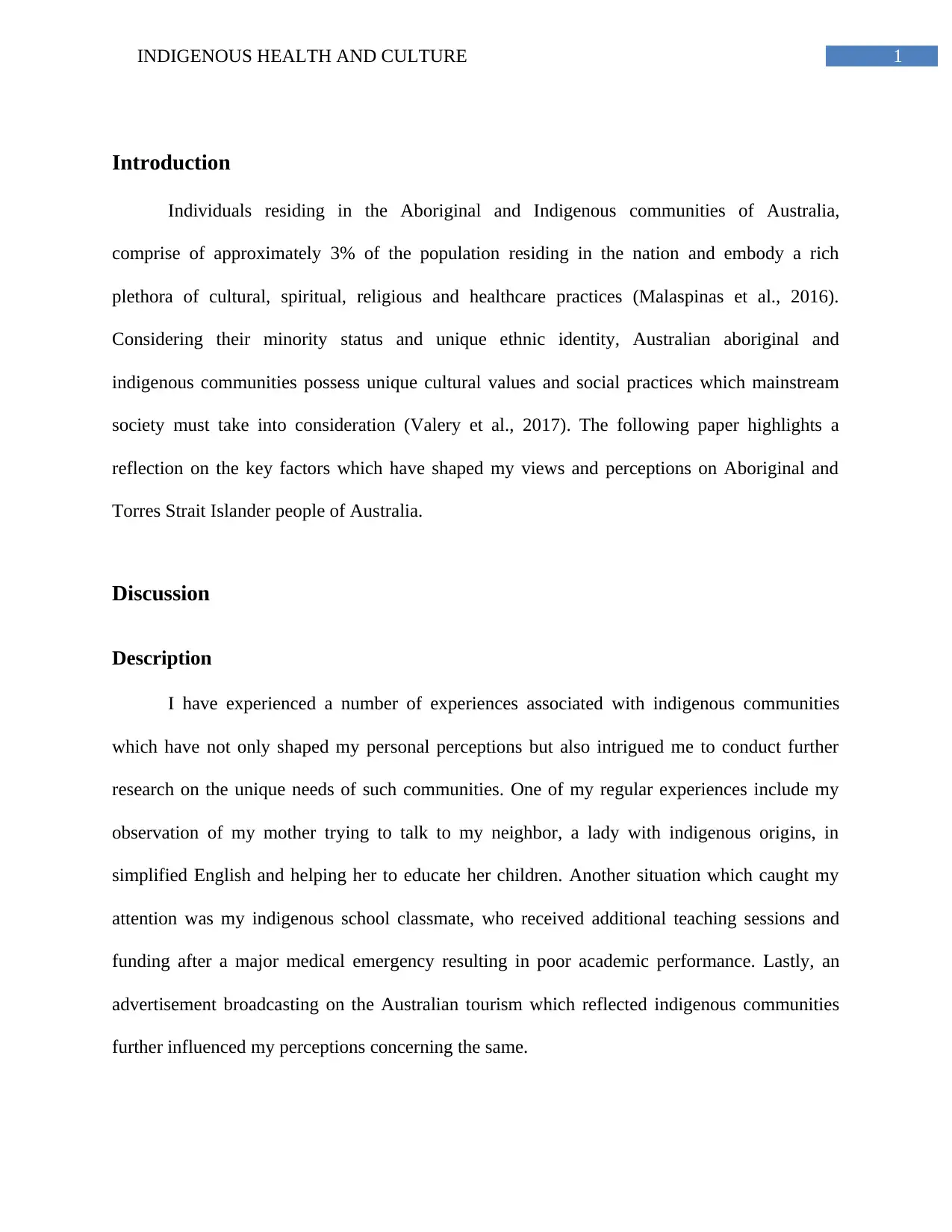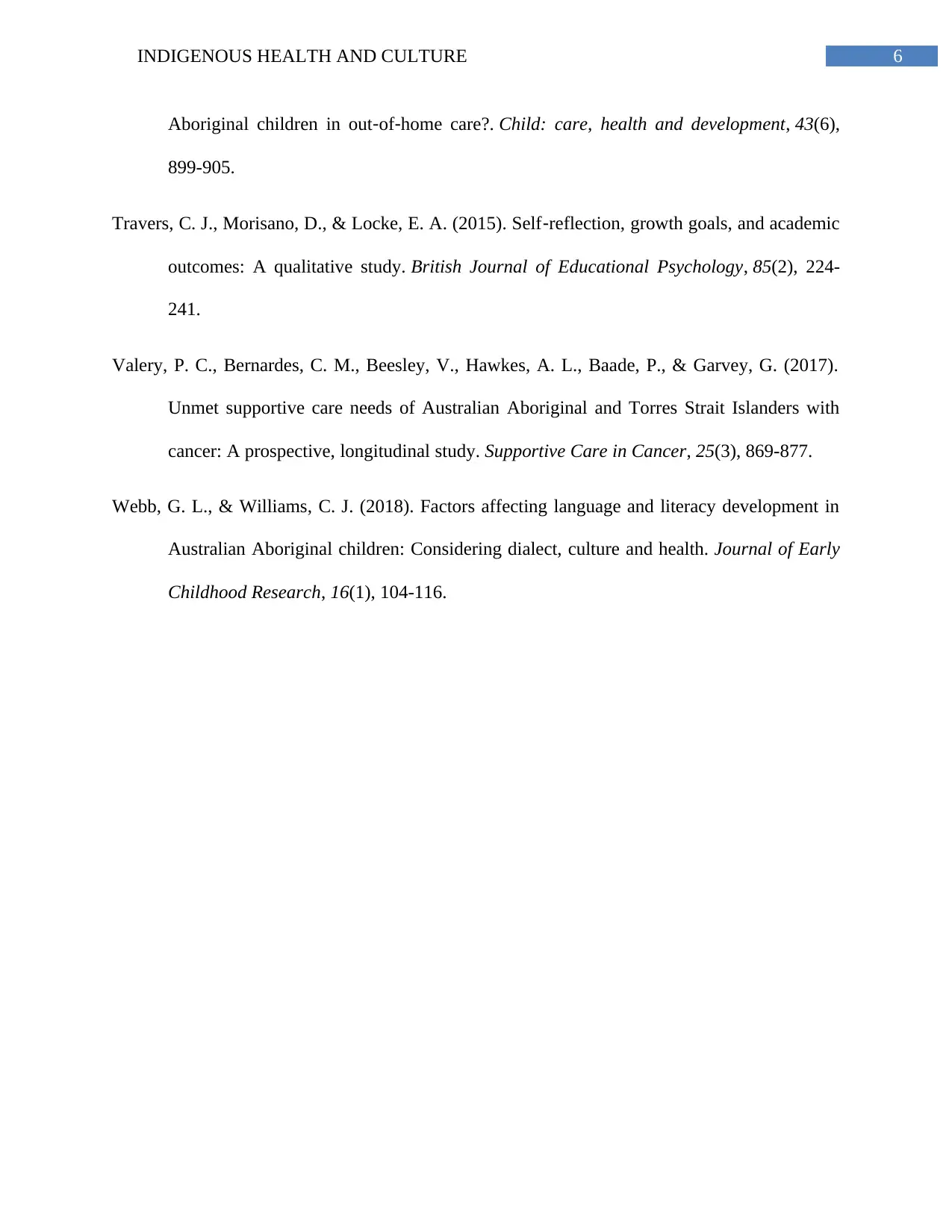Indigenous Health and Culture
VerifiedAdded on 2023/04/08
|7
|1191
|339
AI Summary
This paper discusses the unique cultural values and healthcare practices of Aboriginal and Torres Strait Islander communities in Australia. It explores the author's personal experiences and reflections, as well as the need for empathy, understanding, and culturally competent care.
Contribute Materials
Your contribution can guide someone’s learning journey. Share your
documents today.

Running head: INDIGENOUS HEALTH AND CULTURE
INDIGENOUS HEALTH AND CULTURE
Name of the Student:
Name of the University:
Author note:
INDIGENOUS HEALTH AND CULTURE
Name of the Student:
Name of the University:
Author note:
Secure Best Marks with AI Grader
Need help grading? Try our AI Grader for instant feedback on your assignments.

1INDIGENOUS HEALTH AND CULTURE
Introduction
Individuals residing in the Aboriginal and Indigenous communities of Australia,
comprise of approximately 3% of the population residing in the nation and embody a rich
plethora of cultural, spiritual, religious and healthcare practices (Malaspinas et al., 2016).
Considering their minority status and unique ethnic identity, Australian aboriginal and
indigenous communities possess unique cultural values and social practices which mainstream
society must take into consideration (Valery et al., 2017). The following paper highlights a
reflection on the key factors which have shaped my views and perceptions on Aboriginal and
Torres Strait Islander people of Australia.
Discussion
Description
I have experienced a number of experiences associated with indigenous communities
which have not only shaped my personal perceptions but also intrigued me to conduct further
research on the unique needs of such communities. One of my regular experiences include my
observation of my mother trying to talk to my neighbor, a lady with indigenous origins, in
simplified English and helping her to educate her children. Another situation which caught my
attention was my indigenous school classmate, who received additional teaching sessions and
funding after a major medical emergency resulting in poor academic performance. Lastly, an
advertisement broadcasting on the Australian tourism which reflected indigenous communities
further influenced my perceptions concerning the same.
Introduction
Individuals residing in the Aboriginal and Indigenous communities of Australia,
comprise of approximately 3% of the population residing in the nation and embody a rich
plethora of cultural, spiritual, religious and healthcare practices (Malaspinas et al., 2016).
Considering their minority status and unique ethnic identity, Australian aboriginal and
indigenous communities possess unique cultural values and social practices which mainstream
society must take into consideration (Valery et al., 2017). The following paper highlights a
reflection on the key factors which have shaped my views and perceptions on Aboriginal and
Torres Strait Islander people of Australia.
Discussion
Description
I have experienced a number of experiences associated with indigenous communities
which have not only shaped my personal perceptions but also intrigued me to conduct further
research on the unique needs of such communities. One of my regular experiences include my
observation of my mother trying to talk to my neighbor, a lady with indigenous origins, in
simplified English and helping her to educate her children. Another situation which caught my
attention was my indigenous school classmate, who received additional teaching sessions and
funding after a major medical emergency resulting in poor academic performance. Lastly, an
advertisement broadcasting on the Australian tourism which reflected indigenous communities
further influenced my perceptions concerning the same.

2INDIGENOUS HEALTH AND CULTURE
Feelings
At first, I was quite curious when I observed my mother talking to my neighbor in a
unique tone of English which further encouraged me to communicate her for deeper
understanding. However, I felt quite agitated and hurt when I noticed my mother providing extra
educational support to my neighbor’s children since this with something which I never received.
Further, I also felt angry at the additional educational and financial support provided to my
indigenous classmate since this was something which was not provided to me or the rest of my
friends and was hence, unfair. Further, the indigenous reflection in the tourism advertisement
sparked my curiosity to further investigate the issue.
Evaluation
Upon evaluation, feelings of anger and being unfairly treated were what made my
experience quite negative and hurtful. However, as researched by Travers, Morisano & Locke,
(2015), self reflection and mindfulness towards one’s feelings are beneficial ways in which one
can uncover the reasons underlying negative emotions. Further, as researched by Falster et al.,
(2016), social inequities faced by minority groups often require additional interventions. Hence,
upon reflecting, I realized that such individuals belonging to indigenous communities must have
faced some inequity which required extra assistance. Hence, evaluating the same, I was
encouraged to engage in more research to truly understand needs of such communities. Hence,
the encouragement to research was a positive experience in this situation.
Feelings
At first, I was quite curious when I observed my mother talking to my neighbor in a
unique tone of English which further encouraged me to communicate her for deeper
understanding. However, I felt quite agitated and hurt when I noticed my mother providing extra
educational support to my neighbor’s children since this with something which I never received.
Further, I also felt angry at the additional educational and financial support provided to my
indigenous classmate since this was something which was not provided to me or the rest of my
friends and was hence, unfair. Further, the indigenous reflection in the tourism advertisement
sparked my curiosity to further investigate the issue.
Evaluation
Upon evaluation, feelings of anger and being unfairly treated were what made my
experience quite negative and hurtful. However, as researched by Travers, Morisano & Locke,
(2015), self reflection and mindfulness towards one’s feelings are beneficial ways in which one
can uncover the reasons underlying negative emotions. Further, as researched by Falster et al.,
(2016), social inequities faced by minority groups often require additional interventions. Hence,
upon reflecting, I realized that such individuals belonging to indigenous communities must have
faced some inequity which required extra assistance. Hence, evaluating the same, I was
encouraged to engage in more research to truly understand needs of such communities. Hence,
the encouragement to research was a positive experience in this situation.

3INDIGENOUS HEALTH AND CULTURE
Analysis
Hence, further research encouraged me to adequately analyze my situation. According to
Webb and Williams (2018), aboriginal communities generally belong to non-English speaking
backgrounds which makes them difficult to voice their needs and opinions and also prevents
empathetic understanding from the perspective of mainstream society. Hence, this justifies my
mother speaking differently to my neighbor. Further, as noted by Azzopardi et al., (2018), being
the minority, Aboriginals are often deprived of required educational financial and healthcare
resources or lack affordability and accessibility due to their remote, minority status and residence
as compared to non-indigenous groups hence requiring additional assistance through advocacy
and funding. Being from a privileged background, I realized that additional assistance to my
neighbor and classmate was justified since I was not deprived of required financial, educational
or healthcare resources as compared to them. Lastly, as researched by Carlon and Frazer (2016),
aboriginal communities despite being a minority, posses unique cultural values and ideas which
must be respected, cherished and explored by all. Hence, apart from mainstream Australia,
indigenous communities must equally be represented in media, justifying the tourism
advertisement.
Conclusion and Action Plan
One must be empathetic towards unique needs of individuals such as indigenous
communities and engage in interpersonal communication and patient listening in order to prevent
judgmental attitudes (Raman et al., 2017). Hence, instead of judging and feeling negative
towards the special treatment given to my aboriginal neighbor and classmate, I should have been
empathetic towards their condition. Further, communication and interaction results in prevention
Analysis
Hence, further research encouraged me to adequately analyze my situation. According to
Webb and Williams (2018), aboriginal communities generally belong to non-English speaking
backgrounds which makes them difficult to voice their needs and opinions and also prevents
empathetic understanding from the perspective of mainstream society. Hence, this justifies my
mother speaking differently to my neighbor. Further, as noted by Azzopardi et al., (2018), being
the minority, Aboriginals are often deprived of required educational financial and healthcare
resources or lack affordability and accessibility due to their remote, minority status and residence
as compared to non-indigenous groups hence requiring additional assistance through advocacy
and funding. Being from a privileged background, I realized that additional assistance to my
neighbor and classmate was justified since I was not deprived of required financial, educational
or healthcare resources as compared to them. Lastly, as researched by Carlon and Frazer (2016),
aboriginal communities despite being a minority, posses unique cultural values and ideas which
must be respected, cherished and explored by all. Hence, apart from mainstream Australia,
indigenous communities must equally be represented in media, justifying the tourism
advertisement.
Conclusion and Action Plan
One must be empathetic towards unique needs of individuals such as indigenous
communities and engage in interpersonal communication and patient listening in order to prevent
judgmental attitudes (Raman et al., 2017). Hence, instead of judging and feeling negative
towards the special treatment given to my aboriginal neighbor and classmate, I should have been
empathetic towards their condition. Further, communication and interaction results in prevention
Secure Best Marks with AI Grader
Need help grading? Try our AI Grader for instant feedback on your assignments.

4INDIGENOUS HEALTH AND CULTURE
of barriers between cordial relationships (Forsyth et al., 2017). Hence, I should have
communicated with my mother in order to understand her actions instead of merely judging.
Aboriginal communities deserve to be treated with respect and dignity and mainstream
society must attempt to perform culturally competent care which includes exploration of unique
indigenous needs to fully understand the opinions, preferences and voices of such ethnic
minorities (Clifford et al., 2015). Hence, in my action plan, I will strive to research further into
the needs of Aboriginals and also engage in culturally competent communication and
disseminating non-judgmental, respectful and dignified treatment towards such communities in
the future.
of barriers between cordial relationships (Forsyth et al., 2017). Hence, I should have
communicated with my mother in order to understand her actions instead of merely judging.
Aboriginal communities deserve to be treated with respect and dignity and mainstream
society must attempt to perform culturally competent care which includes exploration of unique
indigenous needs to fully understand the opinions, preferences and voices of such ethnic
minorities (Clifford et al., 2015). Hence, in my action plan, I will strive to research further into
the needs of Aboriginals and also engage in culturally competent communication and
disseminating non-judgmental, respectful and dignified treatment towards such communities in
the future.

5INDIGENOUS HEALTH AND CULTURE
References
Azzopardi, P. S., Sawyer, S. M., Carlin, J. B., Degenhardt, L., Brown, N., Brown, A. D., &
Patton, G. C. (2018). Health and wellbeing of Indigenous adolescents in Australia: a
systematic synthesis of population data. The Lancet, 391(10122), 766-782.
Carlson, B., & Frazer, R. (2016). Indigenous Activism and Social Media. Negotiating Digital
Citizenship: Control, Contest and Culture, 115.
Clifford, A., McCalman, J., Bainbridge, R., & Tsey, K. (2015). Interventions to improve cultural
competency in health care for Indigenous peoples of Australia, New Zealand, Canada and
the USA: a systematic review. International Journal for Quality in Health Care, 27(2),
89-98.
Falster, K., Banks, E., Lujic, S., Falster, M., Lynch, J., Zwi, K., ... & Jorm, L. (2016).
Inequalities in pediatric avoidable hospitalizations between Aboriginal and non-
Aboriginal children in Australia: a population data linkage study. BMC pediatrics, 16(1),
169.
Forsyth, C. J., Irving, M. J., Tennant, M., Short, S. D., & Gilroy, J. A. (2017). Teaching cultural
competence in dental education: a systematic review and exploration of implications for
indigenous populations in Australia. Journal of dental education, 81(8), 956-968.
Malaspinas, A. S., Westaway, M. C., Muller, C., Sousa, V. C., Lao, O., Alves, I., ... & Heupink,
T. H. (2016). A genomic history of Aboriginal Australia. Nature, 538(7624), 207.
Raman, S., Ruston, S., Irwin, S., Tran, P., Hotton, P., & Thorne, S. (2017). Taking culture
seriously: Can we improve the developmental health and well‐being of Australian
References
Azzopardi, P. S., Sawyer, S. M., Carlin, J. B., Degenhardt, L., Brown, N., Brown, A. D., &
Patton, G. C. (2018). Health and wellbeing of Indigenous adolescents in Australia: a
systematic synthesis of population data. The Lancet, 391(10122), 766-782.
Carlson, B., & Frazer, R. (2016). Indigenous Activism and Social Media. Negotiating Digital
Citizenship: Control, Contest and Culture, 115.
Clifford, A., McCalman, J., Bainbridge, R., & Tsey, K. (2015). Interventions to improve cultural
competency in health care for Indigenous peoples of Australia, New Zealand, Canada and
the USA: a systematic review. International Journal for Quality in Health Care, 27(2),
89-98.
Falster, K., Banks, E., Lujic, S., Falster, M., Lynch, J., Zwi, K., ... & Jorm, L. (2016).
Inequalities in pediatric avoidable hospitalizations between Aboriginal and non-
Aboriginal children in Australia: a population data linkage study. BMC pediatrics, 16(1),
169.
Forsyth, C. J., Irving, M. J., Tennant, M., Short, S. D., & Gilroy, J. A. (2017). Teaching cultural
competence in dental education: a systematic review and exploration of implications for
indigenous populations in Australia. Journal of dental education, 81(8), 956-968.
Malaspinas, A. S., Westaway, M. C., Muller, C., Sousa, V. C., Lao, O., Alves, I., ... & Heupink,
T. H. (2016). A genomic history of Aboriginal Australia. Nature, 538(7624), 207.
Raman, S., Ruston, S., Irwin, S., Tran, P., Hotton, P., & Thorne, S. (2017). Taking culture
seriously: Can we improve the developmental health and well‐being of Australian

6INDIGENOUS HEALTH AND CULTURE
Aboriginal children in out‐of‐home care?. Child: care, health and development, 43(6),
899-905.
Travers, C. J., Morisano, D., & Locke, E. A. (2015). Self‐reflection, growth goals, and academic
outcomes: A qualitative study. British Journal of Educational Psychology, 85(2), 224-
241.
Valery, P. C., Bernardes, C. M., Beesley, V., Hawkes, A. L., Baade, P., & Garvey, G. (2017).
Unmet supportive care needs of Australian Aboriginal and Torres Strait Islanders with
cancer: A prospective, longitudinal study. Supportive Care in Cancer, 25(3), 869-877.
Webb, G. L., & Williams, C. J. (2018). Factors affecting language and literacy development in
Australian Aboriginal children: Considering dialect, culture and health. Journal of Early
Childhood Research, 16(1), 104-116.
Aboriginal children in out‐of‐home care?. Child: care, health and development, 43(6),
899-905.
Travers, C. J., Morisano, D., & Locke, E. A. (2015). Self‐reflection, growth goals, and academic
outcomes: A qualitative study. British Journal of Educational Psychology, 85(2), 224-
241.
Valery, P. C., Bernardes, C. M., Beesley, V., Hawkes, A. L., Baade, P., & Garvey, G. (2017).
Unmet supportive care needs of Australian Aboriginal and Torres Strait Islanders with
cancer: A prospective, longitudinal study. Supportive Care in Cancer, 25(3), 869-877.
Webb, G. L., & Williams, C. J. (2018). Factors affecting language and literacy development in
Australian Aboriginal children: Considering dialect, culture and health. Journal of Early
Childhood Research, 16(1), 104-116.
1 out of 7
Related Documents
Your All-in-One AI-Powered Toolkit for Academic Success.
+13062052269
info@desklib.com
Available 24*7 on WhatsApp / Email
![[object Object]](/_next/static/media/star-bottom.7253800d.svg)
Unlock your academic potential
© 2024 | Zucol Services PVT LTD | All rights reserved.





